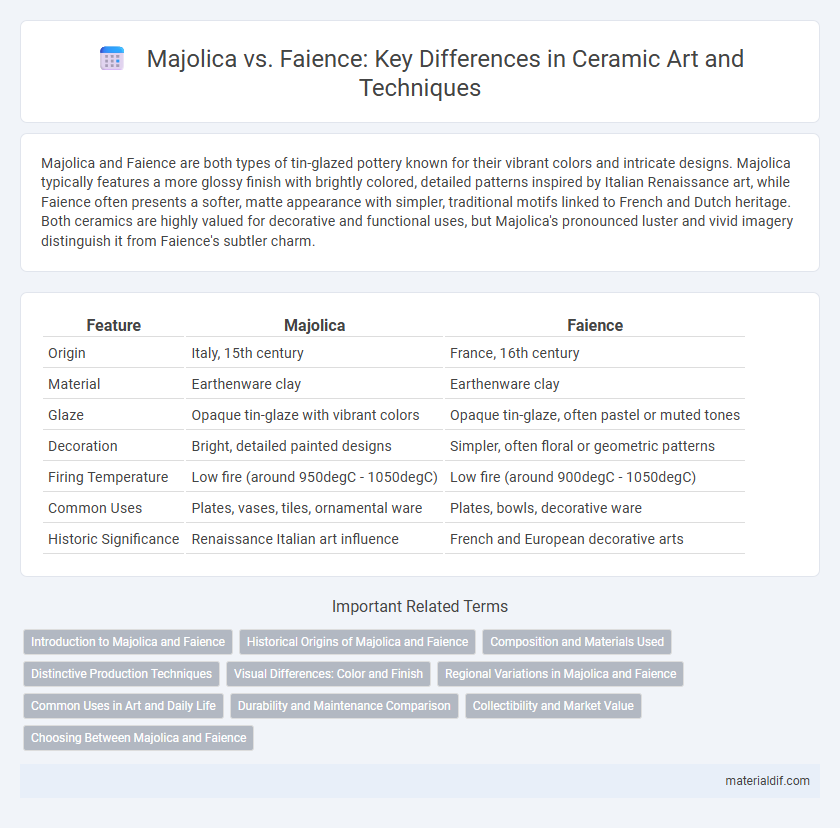Majolica and Faience are both types of tin-glazed pottery known for their vibrant colors and intricate designs. Majolica typically features a more glossy finish with brightly colored, detailed patterns inspired by Italian Renaissance art, while Faience often presents a softer, matte appearance with simpler, traditional motifs linked to French and Dutch heritage. Both ceramics are highly valued for decorative and functional uses, but Majolica's pronounced luster and vivid imagery distinguish it from Faience's subtler charm.
Table of Comparison
| Feature | Majolica | Faience |
|---|---|---|
| Origin | Italy, 15th century | France, 16th century |
| Material | Earthenware clay | Earthenware clay |
| Glaze | Opaque tin-glaze with vibrant colors | Opaque tin-glaze, often pastel or muted tones |
| Decoration | Bright, detailed painted designs | Simpler, often floral or geometric patterns |
| Firing Temperature | Low fire (around 950degC - 1050degC) | Low fire (around 900degC - 1050degC) |
| Common Uses | Plates, vases, tiles, ornamental ware | Plates, bowls, decorative ware |
| Historic Significance | Renaissance Italian art influence | French and European decorative arts |
Introduction to Majolica and Faience
Majolica and Faience are types of tin-glazed pottery known for their vibrant colors and intricate designs, originating in Renaissance Italy and France respectively. Majolica typically features a white opaque glaze with detailed painted scenes, while Faience is characterized by a glossy surface and often more muted palette inspired by Dutch Delftware. Both ceramics showcase the artistic evolution of glazing techniques that enhanced decorative and functional attributes of earthenware.
Historical Origins of Majolica and Faience
Majolica originated during the Italian Renaissance in the 15th century as tin-glazed pottery featuring vibrant, intricate designs inspired by Mediterranean art. Faience, with roots tracing back to 16th-century France and earlier to Spanish and Middle Eastern ceramics, is known for its opaque tin glaze that creates a white, glossy surface ideal for detailed painting. Both types reflect significant cultural exchanges along Mediterranean trade routes, influencing European decorative ceramics with their distinct glazing techniques and artistic styles.
Composition and Materials Used
Majolica ceramics are characterized by a tin-glazed earthenware base coated with a white, opaque glaze infused with metallic oxides for vibrant colors, primarily utilizing clay mixed with kaolin and quartz. Faience, on the other hand, comprises a lead-glazed earthenware body with a tin glaze that produces a bright white surface, typically formulated with clay enriched with feldspar and silica to enhance durability and translucency. Both types leverage tin glazing but differ significantly in clay composition and the specific mineral additives that influence their texture and finish.
Distinctive Production Techniques
Majolica ceramics are recognized for their tin-glazed earthenware technique, where a white, opaque glaze serves as a canvas for vibrant, hand-painted designs fired at a low temperature. Faience, by contrast, employs a lead-glaze method on porous earthenware, producing a translucent finish that enhances intricate surface decoration often applied using stencils or transfers. The key difference lies in Majolica's tin oxide glaze creating a bright, glossy background ideally suited for vivid colors, whereas Faience's lead glaze yields a more muted, glossy surface that emphasizes texture and subtler tones.
Visual Differences: Color and Finish
Majolica ceramics are characterized by their vibrant, glossy glazes with bright, often multicolored hues that create a lively and reflective surface. Faience pottery typically features a matte or satin finish with softer, more muted colors, often in shades of blue, green, or white, giving it a more understated and earthy appearance. The visual distinction lies in Majolica's high-gloss, colorful decoration compared to Faience's subtler tones and less reflective surface.
Regional Variations in Majolica and Faience
Majolica ceramics prominently originate from Italy, especially regions like Deruta and Faenza, known for their vibrant tin-glazed earthenware featuring intricate painted designs. Faience, in contrast, has strong historical roots in France and Germany, with notable centers like Rouen and Strasbourg producing pieces characterized by softer, pastel-colored glazes and more restrained decoration. These regional variations in majolica and faience highlight distinct techniques, color palettes, and artistic influences that define their cultural identities within European ceramic traditions.
Common Uses in Art and Daily Life
Majolica ceramics feature vibrant, tin-glazed surfaces ideal for decorative art pieces, tiles, and tableware, making them popular for ornamental display and functional dining settings. Faience is commonly used for everyday pottery such as plates, bowls, and jars, valued for its durability and rustic appeal in kitchens and homes. Both types serve as artistic mediums but differ in glaze technology, influencing their aesthetic roles and practical applications in daily life.
Durability and Maintenance Comparison
Majolica ceramics are typically coated with a tin glaze that makes them more durable and resistant to chipping compared to faience, which often features a softer, lead-based glaze prone to wear over time. The non-porous surface of majolica facilitates easier cleaning and reduces staining, whereas faience requires gentler maintenance to avoid damaging its more delicate glaze. Both materials benefit from careful handling, but majolica's enhanced resistance suits high-traffic or functional use better than faience's decorative applications.
Collectibility and Market Value
Majolica pottery, characterized by its vibrant, tin-glazed finish, tends to have higher collectibility and market value due to its intricate designs and historical significance, especially pieces from renowned European manufacturers. Faience, while also tin-glazed, generally commands lower prices but remains sought after for its rustic charm and regional variations, particularly French and Italian wares. Collectors prioritize Majolica for its rarity and decorative appeal, making it a more lucrative investment in the ceramics market.
Choosing Between Majolica and Faience
Choosing between majolica and faience depends on the desired glaze and decoration style; majolica features a tin-glazed, brightly colored surface with intricate painted designs, while faience often has a more muted palette with a smoother, less glossy finish. Majolica ceramics are ideal for vibrant, decorative pieces with a historical Renaissance aesthetic, whereas faience suits functional items with a subtle, classic look. Consider the end use and visual impact when selecting between these distinctive European earthenware styles.
Majolica vs Faience Infographic

 materialdif.com
materialdif.com